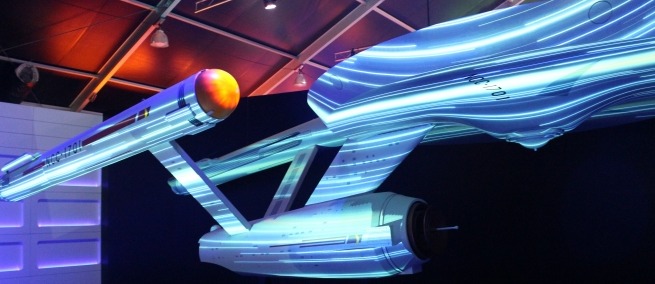
Science & Film’s Sonia Epstein ventured west of the West Side Highway to Star Trek: The Starfleet Academy Experience at the Intrepid Sea, Air & Space Museum on Wednesday, August 17. The cruise ship “Carnival Sunshine,” with over three thousand portholes, was docked on the next pier. A breeze off the Hudson River cooled the crowd of people waiting for admission to Star Trek.
Inside, the exhibition had blue lights, gray-carpeted floors, and white walls with iridescent panels. Moving through the different rooms of Star Trek required diagnosing a medical disease, plotting the course for an emergency landing, and rescuing crewmembers from a ship under attack. I also teleported. It took 15 seconds.
The transporter was a major technological advance achieved by STAR TREK’S Starfleet Academy. Forget Skype calls or holographic projections—the transporter moves a person from one location to another. According to an exhibition note, “transporters dematerialize matter, transmit it as energy, and reassemble that energy into matter at the target location.” The STAR TREK series takes place only about 200 years in the future. In the real world, energy cannot be created or destroyed, it can only change form. This implies that it could be possible for energy to change into matter. Transporting a person requires that every human particle be scanned and then converted. However, Heisenberg’s “Uncertainty Principle” asserts it is impossible to achieve the precision necessary to scan particles at a subatomic level. STAR TREK thus created the “Heisenberg compensator,” which claims to address this issue.
This year, 2016, is the 50th Anniversary of STAR TREK. The Intrepid’s gift shop manager–trying to sell anniversary t-shirts and miniaturized Starfleet ships–was very excited about the latest film, STAR TREK BEYOND, now in theaters.
Star Trek: The Starfleet Academy Experience is on view at the Intrepid Museum through October 31, 2016.